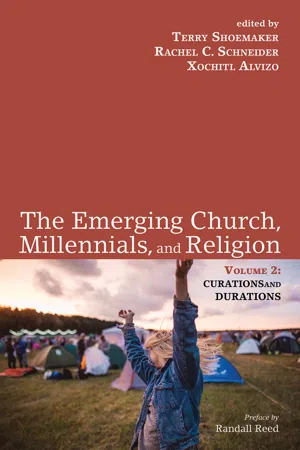![]()
part 1
Curating and Enduring at the Margins
![]()
1
Goosing the Emerging Church
The Wild Goose Festival
Randall Reed
Abstract
Wild Goose Festival is an Emerging Church event held in the mountains of North Carolina every summer. From 2015 to 2017 my research assistants and I interviewed millennial attendees at Wild Goose. It appeared that the Emerging Church movement offered millennials a lot of what they want in religion. It is politically progressive, accepting of diversity, and committed to dialog. Our goal was to determine the issues important to and attitudes held by those millennials who attended a festival like Wild Goose both in regard to the traditional church and the Emerging Church. What we found was that while these millennials did have generally positive views of the Emerging Church as found at Wild Goose, they are not inclined to embrace it as the avenue to return to church.
Introduction
Hot Springs is a small town nestled in the Appalachian Mountains in Western North Carolina. Located about an hour from the city of Asheville and three hours from the closest major airport of Charlotte, it is a tranquil place best known for its hot tubs and as a stopping point for hikers on the Appalachian Trail. Finding a room in one of the several inns around the area is not difficult and the town’s most interesting historical aspect was it served as a prisoner of war (POW) camp during the second world war.
But at the beginning of July things change dramatically as the Emerging Church festival “Wild Goose” comes to town. For five days, cars come streaming into town, every room in the town and surrounding environs is occupied, the scent of beer fills the air along with a hint of hymns and the smell of the unwashed. Wild Goose was started in 2011, fashioned as an American version of the British festival Greenbelt. It originally met at a farm outside of Raleigh, NC, but moved to the mountains of North Carolina in 2013.
The festival in 2011 included Emerging Church luminaries like Brian McLaren, Phyllis Tickle, Shane Claiborne, Tony Campolo, Diana Butler Bass, Frank Schaffer, Jay Bakker, Peter Rollins, Doug Pagitt, Tony Jones, Nadia Bolz-Weber, Kester Brewin, and many others. Today, Brian McLaren and Doug Pagitt remain on the board and many of that original cast still make occasional appearances.
The festival itself is part music, part community, part religion. Large tents with folding chairs and makeshift stages interspersed with food trucks line the thoroughfares within the campground leading to the main stage that has continuous music acts during the day and into the night with the occasional keynote speaker. Musicians are often religious though previous headliners have included the Indigo Girls and Dar Williams, who are more folk stars than noted for their religious music. The speakers in the tents vary from more religiously oriented themes to more activist and progressive politics mixed with religion. In 2017 the Rev. William Barber, known for his “Moral Monday” campaign of resistance against North Carolina’s legislature, was one of the keynote speakers. Talks tend to focus on activism and/or self-help with titles like “Privilege, Power, Racism and Other Biases—Awareness & Action Steps,” “A Faithful Response to Domestic Violence,” “Smiling Heart Yoga,” and “Peace, Justice, and Pentecostalism,” to the more off-beat like “The Tantra of Jesus Christ,” “My Altar is the Baseball Diamond,” and “Christo-Shamanic Transfiguration Ceremony.” But along with these speaker-oriented venues one finds tents where one can engage in art, in storytelling, a tattoo booth, and places to listen to poetry slams.
Pierre Bourdieu’s groundbreaking essay, The Genesis and Structure of the Religious Field suggests an economic model for understanding religion. Using the notion of “field,” he argued that there is a relationship between religious producers of religious products, largely understood as churches and denominations, administered by the clergy, and religious consumers (laity). Bourdieu argues that within the religious field there is then the creation of religious capital. But Bourdieu also suggests that these religious producers function as a way of justifying and legitimating the status quo. As he notes, “theodicies are always sociodicies.”
The goal of religious producers, argues Bourdieu, is the creation of religious monopoly. Robert P. Jones, in his work The End of White Christian America, argues that essentially this is what has happened in the U.S., particularly in the latter half of the twentieth century. Jones suggests that the combination of white mainline and evangelical Christianities constituted a homogenous block that naturalized a largely white Protestant Christian vision of society and culture in the United States. And while not eliding the differences between these two branches, the two share an ethos which, from Bourdieu’s perspective, might well constitute a religious monopoly.
Into this religious marketplace, Bourdieu, envisions the emergence of the “prophet” who he calls a “petty independent entrepreneur of salvation.” Bourdieu, following Weber, focuses on the prophet as an individual. And yet, as we look at the Emerging Church as well as the rise of the nones and increasing religious disaffiliation among millennials and Gen-Z, the necessity of a singular leader seems an artifact of previous experience (modeled on the Protestant Reformation). However, even by extracting the individual leader from Bourdieu’s model this analysis still seems quite explanatory in the example such as Wild Goose where a prophetic movement seeks:
What Bourdieu describes here is the breakdown of a religious social order (monopoly). Bourdieu envisions this monopoly being replaced by an alternative religious producer, and certainly when I began this study, I thought it was possible that the Emerging Church Movement might, in fact, function as that religious entrepreneurial movement that would break up the monopoly of the mainline-evangelical synthesis. The Emerging Church consists of not a prophet but the rejection of the prophetic office in favor of a more general adoption of prophecy. While there are leaders in the Emerging Church movement, most spend their time not ac...
